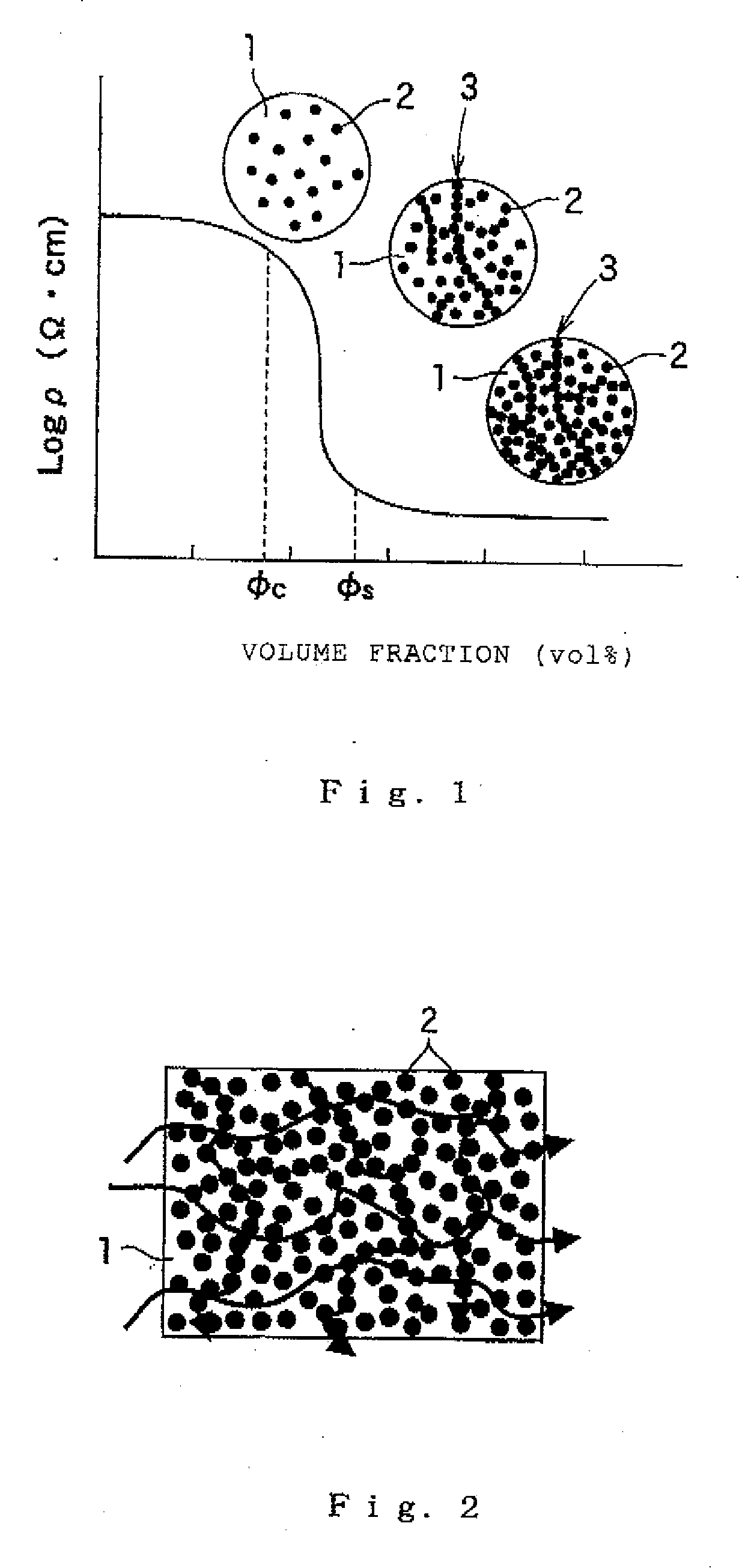Crosslinked elastomer body for sensor, and production method therefor
a technology of crosslinked elastomers and sensors, which is applied in the direction of organic conductors, non-metal conductors, conductive materials, etc., can solve the problems of difficult to provide stable measurement, sensor detection value (resistance value) with respect to strain, and limited shape design flexibility of sensors, etc., to achieve excellent compatibility
- Summary
- Abstract
- Description
- Claims
- Application Information
AI Technical Summary
Benefits of technology
Problems solved by technology
Method used
Image
Examples
example 1
Preparation of Crosslinked EPDM Containing Spherical Particulate Carbon Filler (High Conductor)
[0068] First, 85 parts by weight (hereinafter referred to simply as “parts”) (85 g) of an oil extension ethylene-propylene-diene terpolymer (EPDM)(ESPRENE 6101 available from Sumitomo Chemical Co., Ltd.), 34parts (34 g) of an oil extension EPDM-(ESPRENE 601 available from Sumitomo Chemical Co., Ltd.), 30 parts (30 g) of an EPDM (ESPRENE 505 available from Sumitomo Chemical Co., Ltd.), 5 parts (5 g) of zinc oxide (two types of zinc oxide available from Hakusui Tech Co., Ltd.), 1 part (1 g) of stearic acid (LUNAC S30 available from Kao Corporation) and 20 parts (20 g) of a paraffin process oil (SUNPAR 110 available from Nippon Sun Oil Company) were kneaded by a roll kneader. Then, 270 parts (270 g) of a spherical particulate carbon filler (NICABEADS ICB0520 available from Nippon Carbon Co., Ltd.) having an average particle diameter of 5 μm and a D90 / D10 ratio of 3.2 in particle diameter fr...
example 2
Preparation of Crosslinked EPDM Containing Spherical Particulate Carbon Filler (Intermediate Conductor)
[0071] An electrically conductive composition was prepared in substantially the same manner as in Example 1, except that the spherical particulate carbon filler (NICABEADS ICB0520 available from Nippon Carbon Co., Ltd.) was blended in a proportion of 260 parts (260 g) The spherical particulate carbon filler (electrically conductive filler) was present in a volume fraction of about 47 vol % in the electrically conductive composition, and had a percolation critical volume fraction (φc) of 43 vol % and a saturated volume fraction (φs) of 48 volt.
[0072] Then, the electrically conductive composition was formed into an uncrosslinked rubber sheet having dimensions of 150 mm×1500 mm×2 mm (thickness) As in Example 1, the uncrosslinked rubber sheet was filled in a rectangular box-shaped mold having dimensions of 10 mm×10 mm×5 mm (height), and press-vulcanized at a temperature of 170° C. f...
example 3
Preparation of Crosslinked EPDM Containing Spherical Particulate Carbon Filler (Low Conductor)
[0074] An electrically conductive composition was prepared in substantially the same manner as in Example 1, except that the spherical particulate carbon filler (NICABEADS ICB0520 available from Nippon Carbon Co., Ltd.) was blended in a proportion of 240 parts (240 g) The spherical particulate carbon filler (electrically conductive filler) was present in a volume traction of about 45 vol % in the electrically conductive composition, and had a percolation critical volume fraction (φc) of 43 vol % and a saturated volume fraction (φs) of 48 vol % Then, the electrically conductive composition was formed into an uncrosslinked rubber sheet having dimensions of 150 mm×1500 mm×2 mm (thickness). As in Example 1, the uncrosslinked rubber sheet was filled in a rectangular box-shaped mold having dimensions of 10 mm×10 mm×5 mm (height), and press-vulcanized at a temperature of 170° C. for 30 minutes w...
PUM
| Property | Measurement | Unit |
|---|---|---|
| average particle diameter | aaaaa | aaaaa |
| volume fraction | aaaaa | aaaaa |
| volume fraction | aaaaa | aaaaa |
Abstract
Description
Claims
Application Information
 Login to View More
Login to View More - R&D
- Intellectual Property
- Life Sciences
- Materials
- Tech Scout
- Unparalleled Data Quality
- Higher Quality Content
- 60% Fewer Hallucinations
Browse by: Latest US Patents, China's latest patents, Technical Efficacy Thesaurus, Application Domain, Technology Topic, Popular Technical Reports.
© 2025 PatSnap. All rights reserved.Legal|Privacy policy|Modern Slavery Act Transparency Statement|Sitemap|About US| Contact US: help@patsnap.com



